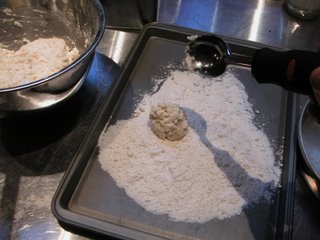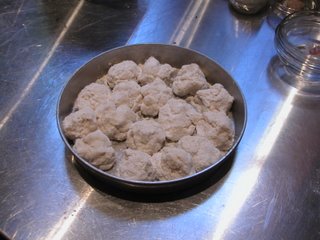Guanciale Pasta alla Gricia
Recipe: Pasta alla Gricia from the New York Times
Published: January 16, 2008
Adapted from Sandro Fioriti
Time: 20 minutes
Salt
1 pound bucatini or rigatoni
1 tablespoon extra virgin olive oil
1 small onion, sliced thin
6 ounces guanciale, in 1-inch slivers 1/4-inch thick
Freshly ground black pepper
1/3 cup grated aged pecorino cheese, more for serving.
1. Bring a large pot of salted water to a boil and add bucatini or rigatoni.
2. Meanwhile, place a 12-inch skillet over medium heat, add olive oil, onion and guanciale. Cook until onion is translucent and barely starting to brown. Remove from heat.
3. When pasta is al dente, drain it, reserving 1 cup pasta water. Transfer pasta to skillet, place over medium-low heat and toss with guanciale and onion. Season with salt and generously with pepper; fold in about half the pasta water and the cheese. Toss, adding more pasta water as needed to help cheese coat pasta. Check seasoning and serve, with more cheese on the side.
Yield: 4 to 6 servings.
Recipe: Bucatini all’Amatriciana
Published: January 16, 2008
Adapted from Michael Tucker
Time: 45 minutes
1 tablespoon extra virgin olive oil
1 medium onion, sliced thin
3 cloves garlic, sliced
1/4 pound guanciale, in 1-inch slivers 1/4 -inch thick
3 cups canned San Marzano tomatoes (about a 28-ounce can)
1/2 teaspoon red chili flakes, or to taste
Salt
1/4 cup grated aged pecorino cheese, more for serving
1 pound bucatini.
1. Heat oil in a 12-inch skillet. Add onion and garlic, and sauté over medium heat until transparent. Add guanciale and sauté until barely beginning to brown.
2. Break up tomatoes and add. Cook about 15 minutes, crushing tomatoes with a spoon, until sauce has become somewhat concentrated and homogenized. Season with chili and salt and stir in 1 tablespoon cheese. Remove from heat.
3. Bring a large pot of salted water to a boil, add bucatini and cook until al dente, about 9 minutes. Drain and transfer to skillet. Gently reheat contents of skillet, folding pasta and tomato sauce together until they are heated through and pasta is well-coated, about 5 minutes. Fold in remaining cheese. Check seasoning and serve with more cheese on the side.
Yield: 4 to 6 servings.
From Michael Tucker and as adapted from the New York Times by the Martha Stewart show.
Serves 4 to 6
3 tablespoons extra-virgin olive oil
1 1/2 tablespoons butter
1/2 pound guanciale, cut into 1-by-1/4-inch pieces
1 yellow onion, thinly sliced
1 small clove garlic, sliced
3 cups (from about one 28-ounce can) canned whole plum tomatoes, preferably San Marzano
1/2 teaspoon crushed red pepper flakes
Coarse salt
1 pound bucatini pasta
1 1/2 cups freshly grated aged pecorino cheese, plus more for serving
1. Heat oil and butter in a large skillet over medium heat. Add guanciale and cook, stirring, until barely beginning to brown. Add onion and garlic and cook, stirring, until translucent.
2. Crush tomatoes and add to skillet. Cook, crushing tomatoes with the back of a spoon, until sauce has thickened, about 15 minutes; season with red pepper flakes and salt.
3. Bring a large pot of salted water to a boil, add bucatini and cook until al dente, about 5 minutes. Drain and transfer to skillet. Return skillet to heat and fold pasta and sauce together until heated through, about 5 minutes. Remove from heat. Fold in 1 1/2 cups cheese; season with salt and serve immediately with more cheese, if desired.










